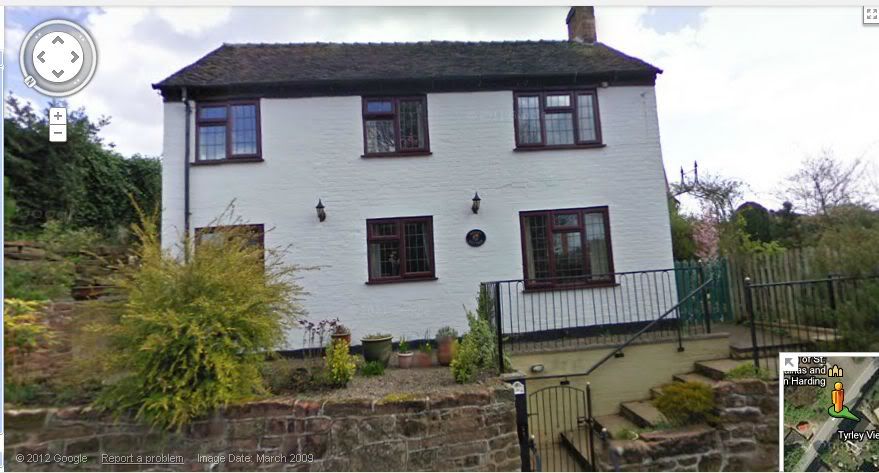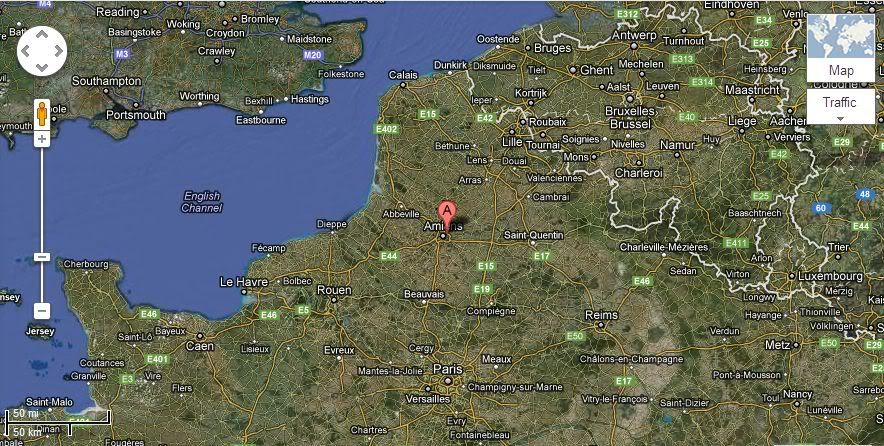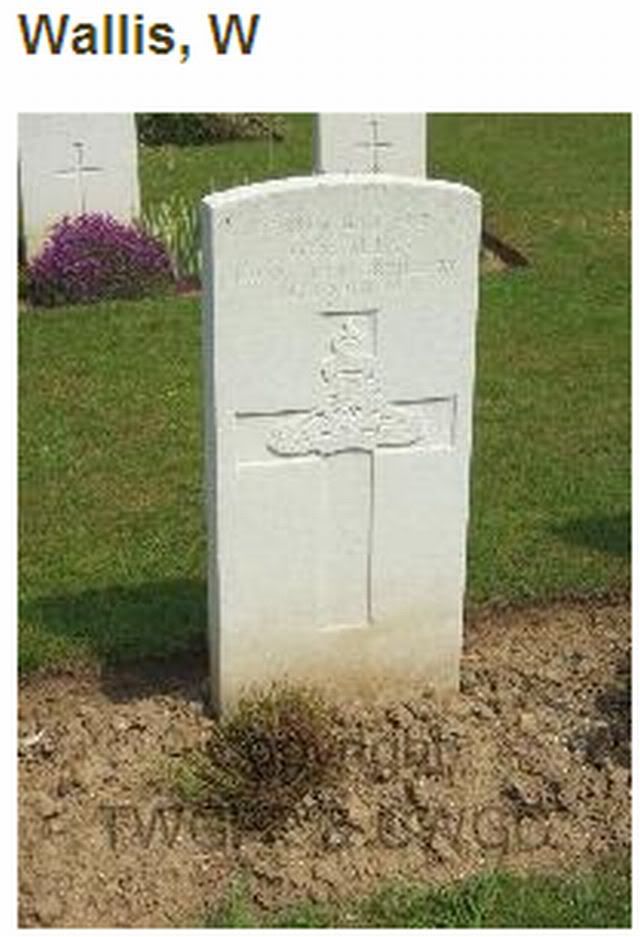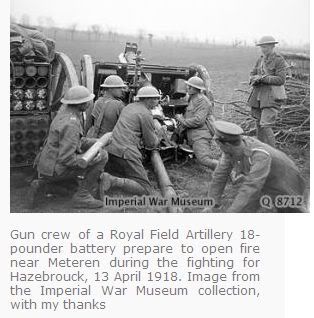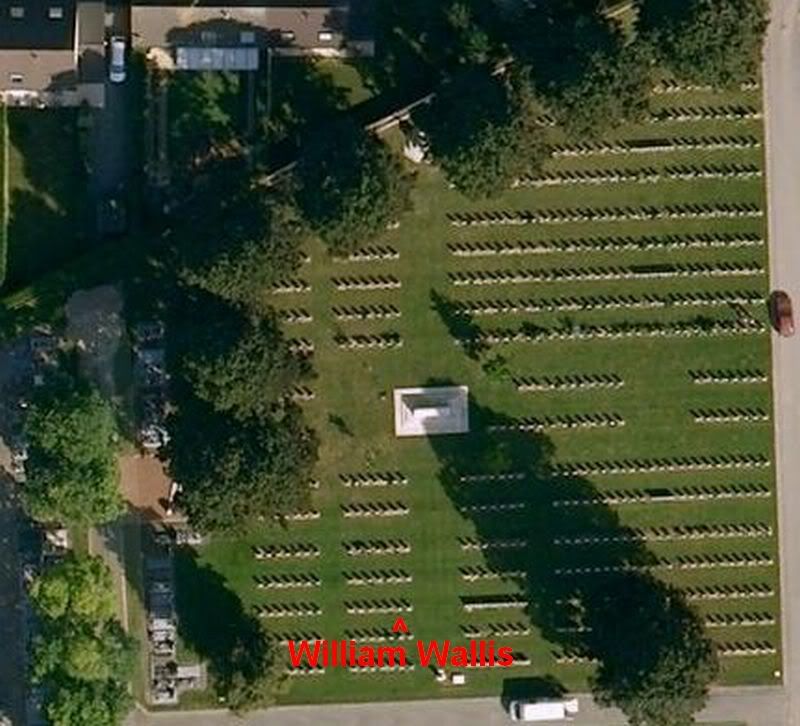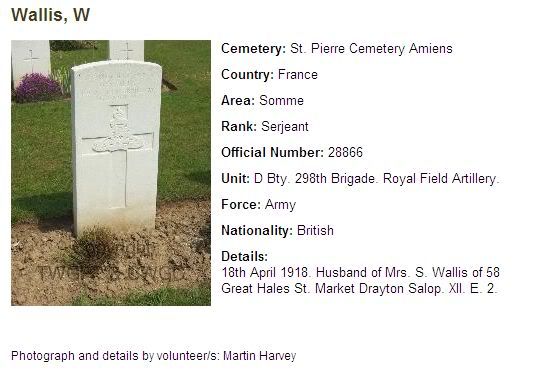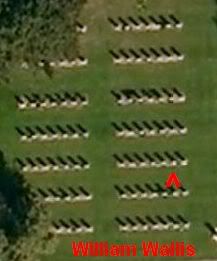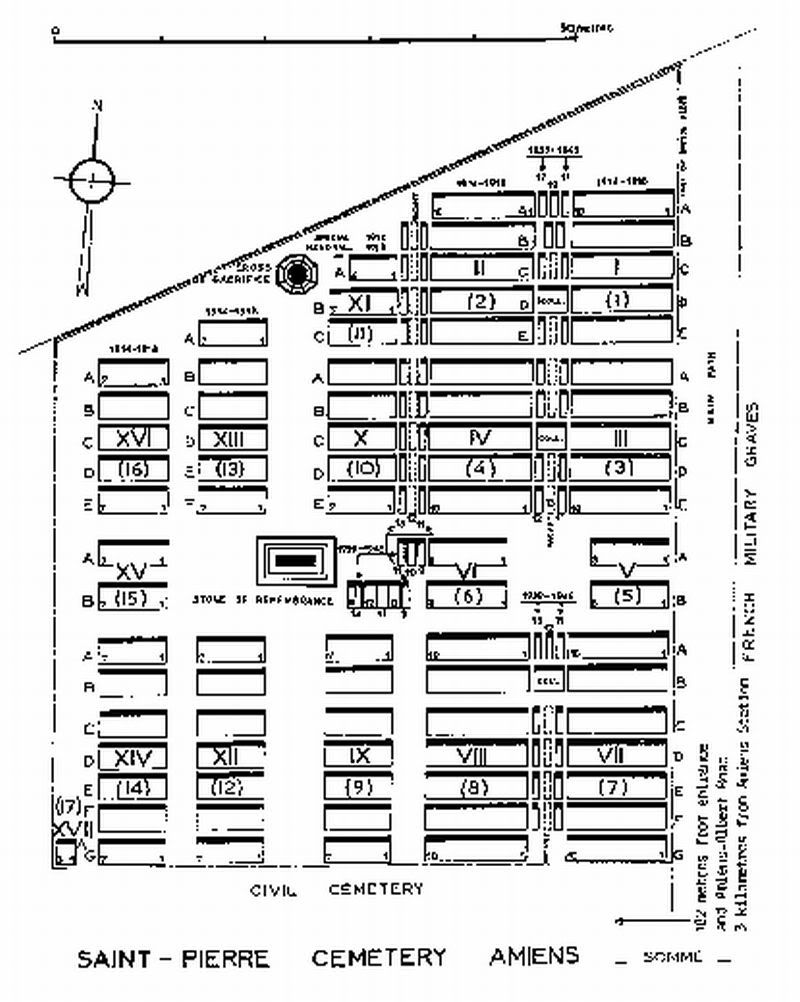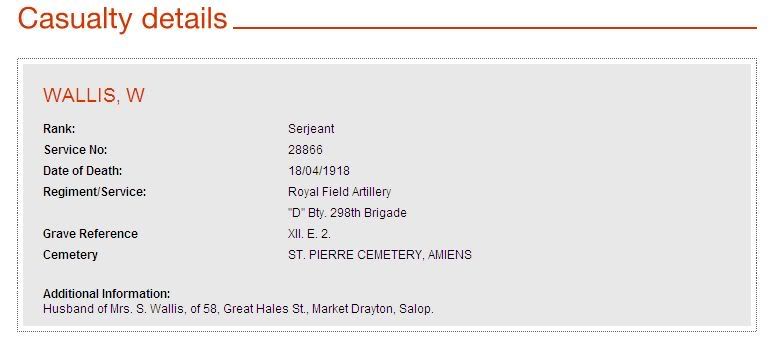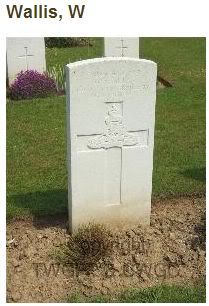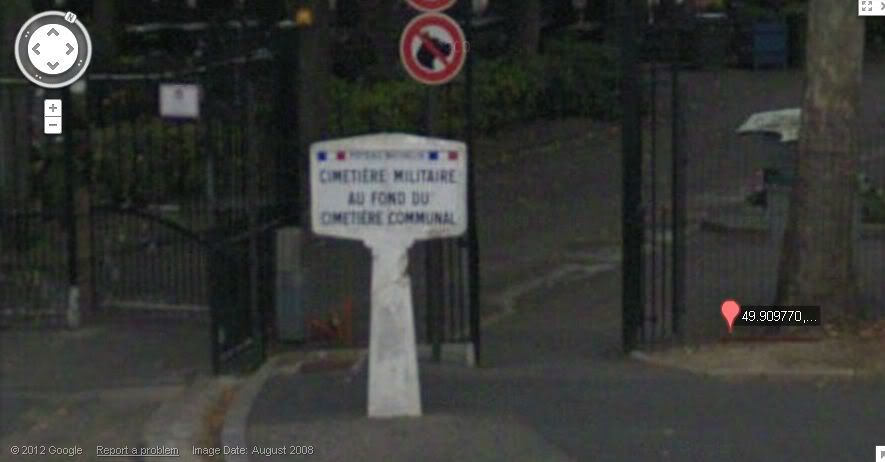TinLizzy

|
|
-

-
Rank:Diamond Member

- Score:1225
- Posts:693
-
From:Canada

- Register:11/07/2008 01:17 AM
|
Date Posted:03/04/2012 04:23 AMCopy HTML
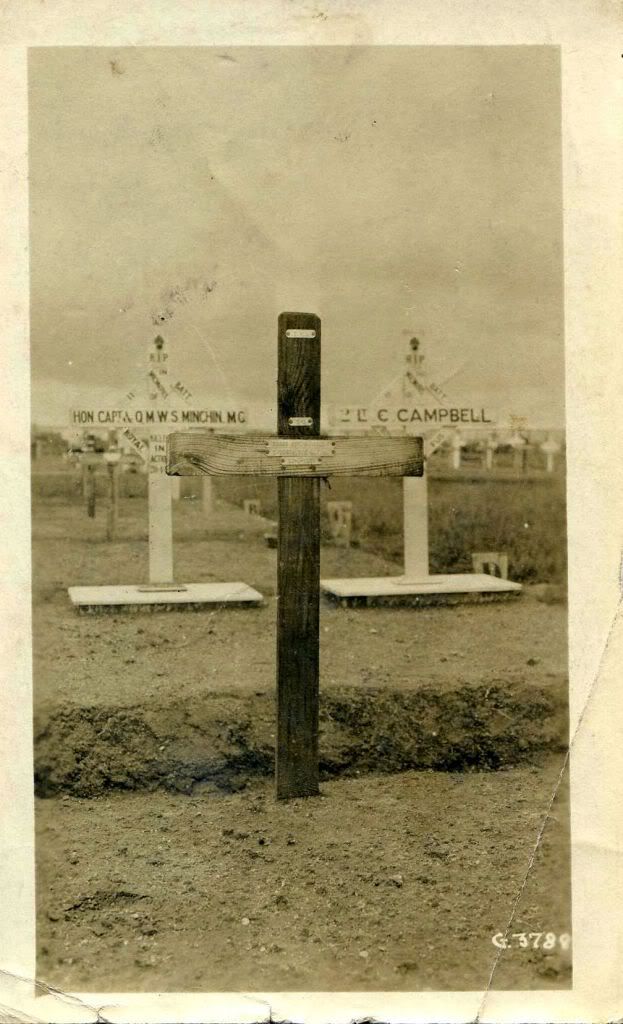 http://www.resthepast.co.uk/army/wardiaries/royalfusiliers/11btn/11thRF.html http://www.resthepast.co.uk/army/wardiaries/royalfusiliers/11btn/11thRF.html
MAP REF. SHEET 28 BELGIUM & FRANCE
Ed 3. 1/40,000
RITZ AREA
1/8/17 The Battalion remained in RITZ AREA. The following casualties occurred;-
9 Other Ranks Wounded – (Gas-Shell) 2 Other Ranks Wounded.
Again the Gassed cases were caused by the Germans using “Mustard Oil”. This Gas burned the mens flesh and caused their eyes to becom bad.
6.pm. At about 6.pm the Battalion left the RITZ AREA and proceeded to DICKEBUSCH AREA occupying Huts at H.27.b.2.6.
DICKEBUSCH AREA Camp at H.27.b.2.6 (Huts)
2/8/17 & 3/8/17 Remained in Huts at H.27.b.2.6. “A” Coy only had the use of the Baths near OUDERDOM on the 3rd August, but a clean dry change of underclothing was issued to the whole of the Battalion.
Draft of 18 Other Ranks Joined the Battalion on the 3rd August 1917.
4/8/17 The Battalion less 1st Line Transport and Specialists moved by route march to CHATEAU SEGARD AREA (see Operation Order No.13 attached) and arrived at No.1. Camp at about 7.pm.
2nd Lieuts C.G. Gore, R.E. Porter and B.H. Barnett joined the Bn. for duty and were posted to “C” “B” “D” Coys respectively.
CHATEAU SEGARD AREA. No.1. Camp. (Dugouts & Bivouacs.)
4/8/17 to 6/8/17 The Battalion remained at No.1. Camp (CHATEAU SEGARD AREA) . Orders for “defence” were issued to all concerned (see copy attached) Operation Orders No.14 and Administrative Orders (copies of both attached) were prepared and issued to all concerned. Enemy Artillery shelled vicinity of camp continuously, apparently in search of numerous batteries around – no shells did any damage to camp and no casualties occurred.
BATTLE POSITION
7/8/17 The Battalion less Transport and Specialists moved by route march to Battle positions (see Operation Orders No.16 attached).
8/8/17 Coy’s and Headquarters remained in their Battle Positions.
9/8/17 Coy’s and Headquarters remained in their Battle Positions.
10/8/17 At 4.30 am. the Battalion attacked WESTHOUK RIDGE in accordance with operation orders No 14. (attached to previous page.) The Companies were commanded as follows:- “A” Company 2nd. Lt. (A/Captain) F.W.E. Hoare, “B” Company Captain D.M. Fuller, “C” Company 2nd Lieut. M. Watt, “D” Company Lieut. A/Capt. H.M. Gray. The Battalion was Commanded by Major. A.E. Sulman, M.C. The Battalion strength on going into action was 37 Officers, 891 Other ranks. Strength on coming out of action 20 Officers 563 Other ranks. Attached is the story of the battle. The following are total of Casualties during this battle.
| Capt. D.M.Fuller |
Killed |
|
Lieut.A/Capt. H.A.Gray |
Missing |
|
Lt.H.P.Cressy |
Missing |
| 2nd.Lt.A/Capt. F.W.E.Hoare |
Killed |
|
2nd.Lt.H.F.Day |
Killed |
|
2/Lt. G.A. Rendle |
Missing |
| 2nd.Lt.G.H.Stovold |
Missing |
|
2nd.Lt.J.J.A.Horton |
Wounded |
|
2nd.Lieut.V.Haddon |
Missing |
| 2nd.Lt.H.P.Chaffey |
Killed |
|
2nd.Lt.R.M.Watt |
Missing |
|
2nd.Lt.R.E.Porter |
Died of Wds |
| 2nd.Lt.A.G.Calthorp |
Missing |
|
2nd.Lt.J.Lang |
Wounded |
|
2nd.Lt.C.G.Gore |
Missing |
| 2nd.Lt.G.W.H.Rogers |
Missing |
|
2nd.Lt.B.H.Barnett |
Missing |
|
|
|
| Other Rank casualties |
328 |
|
2.pm.
The Battalion was relieved by the 8th Norfolk Regiment and proceeded to CHATEAU SEGARD are No.1.
CHATEAU SEGARD
11/8/17 The Battalion moved out of CHATEAU SEGARD Area No.1. and proceeded to DICKEBUSCH HUTS – H.20.c.9.2. (Map Sheet.27 28.N.W. BELGIUM & FRANCE) Hot Tea was waiting for the men on arrival at Huts.
DICKEBUSCH HUTS
12/8/17 The Battalion proceeded by march route to BUSSEBOOM where it embossed at 11.am (See copy of Operation Orders attached No.16.) The Battalion then proceeded to STEENVOORDE EAST Area and after half an hours march after debussing arrived in billets at 3.pm. The 1st line Transport moved independently from Dickebusch huts by road under arrangements of 54th Inf. Bde.
STEENVOORDE EAST AREA
12/8/17 13/8/17 14/8/17 The Battalion rested, cleaned up and were refitted as much as was possible.
The Battalion (less Transport – which proceeded by road under Brigade arrangements) proceeded by march route to ABEELE (See Operation Orders No.17 attached). On arrival at ABEELE Station the Battalion entrained – arrived and detrained at ARNEKE. The Battalion then marched to OOST HOUCK and took over billets in the vicinity of the village.
OOST HOUCK AREA
15/8/17 to 03/9/17 During this period the Battalion carried out training according to programmes laid down Musketry, Close Order drill, Platoon Drill, Platoon attack, Coy Organisation. Physical drill, Rapid Wiring and Bayonet fighting were constantly practiced.
The Rifle Range at EPERLECQUES was allotted to and used by the Battalon on the 22nd August, 28th August and 1st September. The Lewis Gunners were allotted special targets on each occasion.
OOST HOUCK AREA
16/8/17 to 03/9/17 Motor Lorries were placed at the disposal of the Battalion to convey the men to the Range. On the first occasion the lorries made a halt at ST OMER in the evening to enable the men to have a look round the town. On the other two occasions no halt was made owing to the heavy work placed on the lorries.
All Signallers, recruit and trained men, were billeted at Battalion Headquarters to enable the Signalling Sergeant to take them in hand for instruction daily.
Trained and recruit Lewis Gunners were under the Lewis Gun Officer and Lewis Gun N.C.O’s for instruction daily. Staff Sgt. Instructor Newton – G.H.Q. Lewis Gun School – gave practical instruction to the Lewis Gunners on the 17th, 18th, 19th and 20th August.
All equipment, Battle Stores, were overhauled, deficiencies made good and repairs carried out. Steel Helmets were all painted and flashed. Particular attention was paid to the completeness of Ammunition, Field Dressings, P.H. Helmets, Box Respirators, Identity Discs and Rifles.
Latrine Seats, Buckets and Ablution buckets were obtained and issued to all coy’s and Hd.Qrs. for use in the areas occupied by them.
Church parades were held on the 19th and 26th August and 2nd September in the Field adjoining Battalion Headquarters.
OOST HOUCK AREA
16/8/17 TO 3/9/17 On the 20th and 21st August all the Rifles of the Battalion were inspected by the Brigade Armourer. The Commanding Officer inspected Coy Organisation at 2-15.pm. on the 21st August.
On the 19th August authority was given pending confirmation by higher authority, for the following officers to wear badges of higher rank;-
Lieut.A/Capt.G.Dekin………..Captain 2nd.Lieut.G.S.Pearcy………Lieutenant
2nd.Lieut.E.L.Jones………..Lieutenant.
On the 23rd August Sgt.Instructor Bumpstead gave instruction to all Companies N.C.O’s in Bayonet Fighting.
On the 25th August the Battalion was fitted with Box Respirators under the direction of the 54th Brigade Anti-Gas N.C.O.
The Brigade Rifle Range at FOREST d’HAM was used by D and C Coy’s on the 26th August.
The Medical Officer inoculated all Officers and Men who had not been inoculated since March 1916. 2 officers and 8 men were done.
Battalion had baths and clean clothing on the 23rd August and 31st August.
On the 30th August the Brigade Rifle Range at FOREST d’HAM was used by A and B Coy’s.
OOST HOUCK AREA
16/8/17 TO 3/9/17 On the 30th August Lieut.E.H.Cliff and Lieut.G.S.Pearcy were authorised to wear badges of Captain whilst Commanding Companies.
Sports and Games were organized whenever possible. Battalion Boxing tournaments and Football competitions were held.
The following Officers and Other ranks reinforced the Battalion during this period. Joined the Battallion on 14th August
Captain A.D.Welstead...........
Lieut.E.R.Meaker.............
2nd.Lt.M.Taylor...............?
2nd.Lt.J.Buxton.............
See original page for more....would not copy/paste correctly
| Captain A.D.Welstead |
) |
|
|
2nd.Lt.B.H.Beckett |
Joined Battalion |
16-8-17 |
| Lieut.E.R.Meaker |
) |
Joined the Battalion |
|
2nd.Lt.C.C.S.Stockwell |
ditto |
18-8-17 |
| 2nd.Lt.M.Taylor |
) |
on 14th August. |
|
2nd.Lt.C.S.Knott |
ditto |
18-8-17 |
| 2nd.Lt.J.Buxton |
) |
|
|
Lieut.A.Aley |
ditto |
29-8-17 |
| |
|
|
|
2nd.Lt.F.Hankin |
ditto |
2-9-17 |
|
|
|
|
|
OOST HOUCK AREA
3/9/17 The Battalion accompanied by 1st Line Transport moved off at 12-45.pm to ESQUELBECQ Area (see operation Orders No.18 attached). The Battalion arrived in Tents and billets at 3-30.pm.
“A” Coy occupying Billets, “B” Company occupying Billets, Hd.Qrs, “C” and “D” Coy’s occupying tents.
ESQUELBECQ AREA
3/9/17 TO 9/9/17 During this period training was carried out by Companies on same lines as for the OOST HOUCK Area but special attention was paid to a new formation attack, and day and night patrolling was practiced by all Coy’s. Signallers and Lewis Gunners continued training under their respective officers.
On the 3rd September Lieut.E.R.Meaker and Lieut A.Aley were authorised to wear the badges of Captain being the two Officers allotted for the new “Additional” acting Captaincy as laid down in Army Council instructions.
The Brigade Rifle meeting was held on the 6th September at FOREST d’HAM. Open Competitions;- C.S.M. Bailey No.16816 was awarded 3rd Prize. Inter Battalion Officers Competition;- 1st Prize 11th Battalion Royal Fusiliers. Individual Prize, Captain G.S.Pearcy and Lieut W.S.Minchin tied for 1st Prize. Hon Capt in photo
The Battalion carried out and Attack Scheme on the 7th September (see Operation Orders No.19 attached). On the 8th September the Battalion marched to I.1.a. Sheet 27 Belgium and France and were put through a Gas Cloud.
On the 9th September the Baths at WORMHOUDT were allotted to the battalion – clean clothing was issued to each man. Voluntary services for all denominations were held.
During this period the undermentioned reinforced the Battalion :-
| 2nd. Lt. F.A. Leatherland |
2nd. Lt. S.W.Collings |
2nd. Lt. W.H.Stanley |
) |
| 2nd. Lt. J.J. Lawrence |
2nd. Lt. R.G. Simmons |
2nd. Lt. W.Hornfeck |
) All these Officers |
| 2nd. Lt. E.G. Hanwell |
2nd. Lt. H.J.H. Saunders |
2nd. Lt. E.James |
) joined Battalion for |
| 2nd. Lt. H.L. Smedley |
2nd. Lt. E.F. Atterbury |
2nd. Lt. R.W.Gale |
) duty on 6th September |
| 2nd. Lt. B. Tantram |
|
|
) 1917 |
During the period 10th August to 9th September 30 Other Ranks proceeded on Leave, also
Major A.E.Sulman, L.HW.Brookling and 2nd Lt. W.Thomas
ESQUELBECQ
9/9/17 TO 23/9/17 During this period Training was carried out as per Programme laid down, which included Attack Schemes, Mopping-Up Parties, Physical Drill, Bayonet Fighting, New Attack Formation, Platoon Attack, Musketry, Rifle Bombing, Close Order Drill, Rapid Wiring etc (See Programmes attached).
Companies were thoroughly organized. Sports and Games were carried out whenever possible. Stretcher bearers were given special instruction under the Medical Officer.
On the 10th inst., C.R.A. 18th Division gave a lecture at School House, LEDRINGHEM, at 4 p.m. All Company Officers below the rank of Lieutenant and Platoon Sergeant attended. The “Drums” of the Battalion played each evening in the Place, ESQUELBECQ from 5 -6 p.m. The 12th Middlesex Pierrots gave a show in the Bandstand, ESQUELBECQ.
On the 11th inst., Lorries were placed at the disposal of the Battalion, for taking the men who came out of the Battle on the 10th August, to the Seaside. This trip was carried out without incident. Lieut. A. Aley was in charge of the party.
On the 12th September, Lieut-Colonel C.C. Carr, D.S.O., relinquished command of the Battalion, and proceeded to England for reporting to the War Office.
Training as per Operation Orders (No 20 Copy attached) was carried out. Captain A.D. Walstead proceeded to 18th Divisional Headquarters for employment with A.P.M
On the 13th September, the Battalion carried out an Attack Scheme on the Training Area.
2nd Lieut. E.G. Hanwell and 8 Other Ranks were sent to Fifth Army Musketry School for instruction.
On the 14th September, an Officer of the 80th Field Coy. R.E. gave a demonstration on Consolidation of Shell Holes.
Captain E.R. Meaker was detailed as Observing Officer, and proceeded to take Observation Section in hand for training
5 other ranks proceeded to Fifth Army Summer Rest Camp.
84 Other Ranks joined the Battalion as Reinforcements. Strength of Battalion :- 39 Officers, 804 O.R’s.
On the 15th September, 3 Sergeants and 3 Corporals joined the Battalion for duty. 3 Other Ranks proceeded on Leave.
Credit for Francs 42.35 was received for Dripping dispatched for Munition purposes.
On the 16th September (Sunday) Church Parade was held at 9.30 a.m.
No. 8120, Pte Fletcher, S., was awarded the MILITARY MEDAL for gallantry and devotion to duty during the operations against WESTHOEK RIDGE on 10th August 1917.
The following were recipients of “Parchments” issued by Divisional Commander, in recognition of bravery and devotion to duty during operations against WESTHOEK RIDGE on August 10th 1917:-
| “A” Company |
“B” Company |
“C” Company |
“D” Company |
| 15560 Pte Adams, T |
35742 Pte Higgs, A |
47353 Pte Bougourd, A |
8120 Pte Winchester, S |
| 54822 Pte Glenwood, G |
7595 Cpl Hallett, H |
6263 Sgt Berry, H |
35149 Pte Howard, P |
| 7322 Pte Hilton, F |
7631 Pte Leverett, A |
7291 Cpl Emerson, F |
66997 Pte Jakes, A |
| 50578 L/c Maguire, J |
3560 L/c Rickards, W |
9949 L/c Sibley, W |
21878 L/c Jones, F |
| 50388 L/c Pitcher, H |
12247 Sgt Whittington, G |
1696 Sgt Wilson, E |
36738 Cpl Pike, G |
| 7674 Pte Rake, F |
29937 Pte Winter, W |
7255 Cpl Butterworth, F |
5007 Pte Wright, T |
| 60326 Pte Scriven, A |
|
7767 CSM Birch, W |
|
| 4756 L/cWright, T |
|
44001 L/c Eveniss, E |
|
| 703 Pte Watkins, A |
|
7912 Sgt Norton, G |
|
|
|
7977 Pte Tomkins, A |
|
2nd Lieutenant H.L. Smedley took over training of Battalion Observers from Captain E.H. Meaker.
On the 17th September 1917, the Corps Commander awarded the MILITARY MEDAL to the following N.C.O’s and men for gallantry and devotion to duty during the operations against WESTHOEK RIDGE on the 10th August 1917 :-
| “A” Company |
“B” Company |
“C” Company |
“D” Company |
| 703 Pte Watkins, A |
7631 Pte Leverett, A |
7255 L/c Butterworth, F |
66997 Pte Jakes, A |
| 7322 Pte Hilton, F |
29937 L/c Winter, W |
9949 Cpl Sibley, W |
35732 A/Sgt Pike, G |
| 50578 L/c Maguire, J |
12247 Sgt Whittington, G |
47353 Pte Bougourd, A |
35149 Pte Howard, P |
| 50388 L/c Pitcher, H |
3560 Cpl Rickards, W |
7977 Pte Tomkins, A |
5007 Pte Wright, T |
| 7674 Pte Rake, F |
35742 Pte Higgs, A |
44001 L/c Eveniss, E |
21878 L/c Jones, F |
| 54922 Pte Glenwood, A |
|
|
|
2nd Lieutenant F.A. Leatherland and 9 Other Ranks proceeded to Fifth Army Musketry School on a Course.
69 Other Ranks reinforced Battalion. 2 Other Ranks proceeded on Leave.
On the 18th September 1917, the Corps Commander awarded the Bar to the MILITARY MEDAL to:-
No 7291 Cpl. Emerson, F. 7912 Sgt Norton, G.
Training as per Operation orders No 21. (see Copy attached) was carried out.
Two other ranks proceeded on Leave. Captain E.H. Cliff proceeded on Leave.
On the 19th September 1917, the Battalion carried out an Attack Scheme on Training Area. The O.C. 80th Field Coy. R.E. gave a demonstration in four methods of wiring. All Company Officers and Platoon Sergeants attended.
|
TinLizzy

|
Share to:




 #1
#1
|
-

-
Rank:Diamond Member

- Score:1225
- Posts:693
-
From:Canada

- Register:11/07/2008 01:17 AM
|
Re:Grave Photo Research WILLIAM WALLIS
Date Posted:03/04/2012 04:32 AMCopy HTML
http://www.archive.org/stream/royalfusiliersin00onei/royalfusiliersin00onei_djvu.txtTHE ROYAL FUSILIERS IN THE GREAT WAR THE ROYAL FUSILIERS IN THE GREAT WAR BY H. C. O'NEILL, O.B.E. ILLUSTRATED LONDON- WILLIAM HEINEMANN Dedicated by HIS MAJESTY'S GRACIOUS PERMISSION to KING GEORGE V. Colonel-in-Chief, Royal Fusiliers PREFACE To the army the subordinate armies are the units ; to the sectional armies, the army corps ; to the army corps, the divisions ; to the divisions, the brigades ; to the brigades, the battalions. Only when we reach the battalions does the full incidence rest upon the companies and the individuals who compose them. It is this that constitutes the main difficulty of writing a regimental history. In a regiment a private or N. CO. is not X Y Z 123456, but " that bandy-legged little chap who played the fiddle," a distinct and quite human personality. It is the human side of war that is uppermost. But the historian cannot on these grounds excuse himself from dealing with the military framework into which these men fitted. The stress falls in this, as in the more personal side of the war, upon detail. If regimental histories were all written with a perfect knowledge of detail, the history of the war would be made supremely easy for those who have to deal with operations in their larger aspect. But in the case of the Royal Fusiliers the historian is faced with the task of dealing with 235,476 men who fought in every theatre, except Mesopotamia, put in an appearance at almost every considerable battle of the war, and whose dead numbered 21,941. The problem of dealing with the history of these battalions in the space has been extremely difficult, and I have been reluctantly compelled to adopt a compromise. The complete story could not be told in all its detail. On the other hand, the purely military narrative which makes the more irresistible challenge to my mind might have been concentrated, but it would have tended to be lifeless. I have attempted to meet both claims by dealing with every engagement that seemed to deserve notice as correctly and completely as viii PREFACE possible, while singling out incidents appealing to me as more significant. In the final resort some loss of per- spective and some injustice are inevitable. But injustice is inevitable on any plan. In this laborious, though fascinating, inquiry I have been struck by nothing so much as the terrible disproportion and fundamental injustice of the awards. Take, for instance, the one case of the landing of the 2nd Battalion Royal Fusiliers in Gallipoli, which so far has not been justly appreciated. The tardy recognition that came to the battalion came so late that many whose work should have been recognised had fallen, and only the Victoria Cross is given posthumously. Many, of course, fell on the day of the landing ; but many more had passed away before recognition came to the survivors. One or two regiments were seen to fall in heroic action, and their story ran on every one's lips. But other men quite as heroic fell unmarked, frequently unnoticed, by their fellows, and sympathetic friends try to soothe wounded hearts at home by recollections which are frequently found to be incompatible. If I were asked to say what incident in the three landings in Gallipoli,] "X," " W " and " Y," appealed most to me, I should say with little hesitation it was the stand of the gallant company (" X ") of the Royal Fusiliers under Captain Leslie on the left of the " X " beach. The company dwindled to a platoon in the day's fighting. Leslie himself fell. But he held off the repeated onslaughts of the Turks, protected the landing of the 87th Brigade, and made possible that swift march to the right that secured elbow-room for the Lancashire landing. My story therefore is probably not more unjust than in any case it must have been. It is impossible here to set down all the books I have consulted. I have read all I knew to be published. It is also impossible to thank all who have helped me. Without the help of Generals Donald and Newenham I could not have made much headway, and I have received the most generous help .....(...)
|
TinLizzy

|
Share to:




 #2
#2
|
-

-
Rank:Diamond Member

- Score:1225
- Posts:693
-
From:Canada

- Register:11/07/2008 01:17 AM
|
Re:Grave Photo Research WILLIAM WALLIS
Date Posted:03/04/2012 04:33 AMCopy HTML
346 ROYAL FUSILIERS IN THE GREAT WAR
Mepham, Horace Leslie, 2/Lt., k. in a., 11/4/18 (6/Bn., att. 2/Bn.).
Meredith, Eric D., 2/Lt. (Tp.), 32/Bn., k. in a., 4-10/10/16.
Meyricke, Robert James Francis, T/Major (A/Lt.-Col.), 11/Bn., k. in a.,
17/2/17.
Miall-Smith, Ralph A., Lt. (Tp.), 11/Bn., k. in a., 26/9/16.
Michell, Noel Burgess, Capt. (Tp.), n/Bn., k. in a., 22/3/18.
Miles, John Harris, 2/Lt., k. in a., 27/9/15 (7/Bn., att. 4/Bn.).
Miles, Leonard Percy, 2/Lt., k. in a., 7/10/16 (6/Bn., att. 8/Bn.).
Millson, Alvan Ewen, Capt. (Act.), 6/Bn., k. in a., 9/4/17.
Milway, Edwin Horace, 2/Lt. (Tp.), 10/Bn., k. in a., 8/10/18.
Minchin, William Smith, M.C., Capt. and Qr.-Mr., 11/Bn., k. in a.,
|
TinLizzy

|
Share to:




 #3
#3
|
-

-
Rank:Diamond Member

- Score:1225
- Posts:693
-
From:Canada

- Register:11/07/2008 01:17 AM
|
Re:Grave Photo Research WILLIAM WALLIS
Date Posted:03/04/2012 04:37 AMCopy HTML
INDEX Cambrai sector, raids, 221 ; ad- vance from, 318 Cambridge, 49 Cambridge Road Trench, 74 Cameron House, 200 Camerons, the, Ypres, 183 Camies, 2nd Lieut., 107 Campbell, Lieut. -Col., 64 ...? Camping, Lance-Corpl., 127 Canada, Jewish recruits, 26, 27 THE ROLL OF HONOUR 339 Burdett, William Allan, M.C., A/Capt., i/Bn., k. in a., 31/7/17. Burgess, Eric Archibald, 2/Lt., 6/Bn., k. in a., 1 7/2/1 7. Burgess, Reginald Charles, 2/Lt., 23/Bn., k. in a., 3/5/17. Burnham, Andrew William, 2/Lt. (Tp.), 15/Bn., k. in a., 13/11/16. Burton, Charles William Gordon, 2/Lt., 6/Bn., k. in a., 22/1 1/1 7. Bushell, R. H. C, 2/Lt., 7/Bn., k. in a., 27/7/16. Butchard, Robert Archibald, Lt. (Tp.), 31/Bn., k. in a., 5/11/16. Butterworth, Edward Cyril, 2/Lt. (Tp.), 9/Bn., d. of w., 21/11/17. Byng, Arthur Maitland, Capt., k. in a., 14/9/14. Calthrop, Alfred Gordon, 2/Lt., 11/Bn., k. in a., 10/8/17. Calwell, Theophilus Legate, M.C., Lt. (Tp.), 9/Bn., k. in a., 7/10/16. Campbell, Charles, 2/Lt. (Tp.), 11/Bn., d. of w., 20/4/18. Photo?
Campbell, Frederick Charles, 2/Lt., (Tp.), 17/Bn., k. in a., 24/3/18. Campbell, Ronald Walter Francis, Capt. (Tp.), 10/Bn., d. of w., 11/8/16. Cane, Leonard Dobbie, Capt. and Adj. (Tp.), 20/Bn., k. in a., 24/1/16. Carey, Francis Ambrose, 2/Lt., 32/Bn., k. in a., 15/9/16. Carey, Leicester William le Marchant, Capt., k. in a., 17/10/14. Carmichael, David Arthur, Lt., k. in a., 1 7/4/18 (3/Bn., att. M.G. Corps). Carpenter, Clarence, 2/Lt. (Tp.), 23/Bn., k. in a., 1 7/2/1 7. Carr, James Walter, M.C., D.C.M., Lt., died, 16/11/18 (23/Bn., att. 99 http://www.remembering.org.uk/st_pierre_cemetery.htmCaptain William Smith MINCHIN, MC, 11th Battalion Royal Fusiliers, is buried in Plot XII, Row D, Grave 2.
He was killed in action in the Villers-Bretonneux and Amiens area on 20th April1918, aged 46.
Capt Minchin is commemorated on the Cheltenham War Memorial and on the All Saints Church War Memorial.
He left a widow, Mrs Gertrude Annie Minchin, who resided at 64 Fairview Road, Cheltenham.
http://www.cwgc.org/find-a-cemetery/cemetery/20902/ST.%20PIERRE%20CEMETERY,%20AMIENS
ST. PIERRE CEMETERY, AMIENS
<!--Static Image--> 
Location Information
St. Pierre Cemetery is situated on the north-eastern outskirts of Amiens, on the northern side of the main road to Albert. The cemetery will be found in the suburb of Rivery on the left hand side of the D929 Amiens to Albert road.
At the back of the cemetery is the Commonwealth Plot.
Historical Information
During part of August 1914, Amiens was the British Advanced Base. It was captured by the Germans on 31 August, and retaken by the French on the following 13 September. The German offensive which began in March 1918 had Amiens for at least one of its objectives but the Battle of Amiens (8 - 11 August 1918) is the Allied name for the action by which the counter offensive, the Advance to Victory, was begun.
The 7th General Hospital was at Amiens in August 1914; the 56th (South Midland) Casualty Clearing Station from April to July 1916; the New Zealand Stationary Hospital from July 1916 to May 1917; the 42nd Stationary Hospital from October 1917 to March 1919; and the 41st Stationary Hospital in March 1918, and again in December 1918 and January 1919.
The Commonwealth plot in St. Pierre Cemetery was first used in September 1915 and closed in October 1919, but shortly afterwards 33 graves of 1918 were brought in from positions in or near the city.
During the Second World War, Amiens was again a British base, and G.H.Q. reserve was accommodated in the area south-west of the town. There was heavy fighting in and around Amiens when the Germans broke through the Somme line and took the town on 18 May 1940. Much damage was done, but although all the houses to the west of the cathedral were completely destroyed by the bombardment, the cathedral itself and the church of St. Germain l'Ecossais survived. Amiens was retaken by the British Second Army on 31 August 1944. Nos. 25 and 121 General Hospitals were posted there in October 1944, remaining until April 1945.
St. Pierre Cemetery contains 676 Commonwealth burials of the First World War and 82 from the Second World War.
The Commonwealth plot was designed by Sir Edwin Lutyens.
|
TinLizzy

|
Share to:




 #4
#4
|
-

-
Rank:Diamond Member

- Score:1225
- Posts:693
-
From:Canada

- Register:11/07/2008 01:17 AM
|
Re:Grave Photo Research WILLIAM WALLIS
Date Posted:03/04/2012 05:07 AMCopy HTML
| CAMPBELL, CHARLES |
Second Lieutenant |
|
20/04/1918 |
25 |
Royal Fusiliers |
United Kingdom |
XII. D. 1. |
ST. PIERRE CEMETERY, AMIENS |
| MINCHIN, WILLIAM SMITH |
Captain |
|
20/04/1918 |
46 |
Royal Fusiliers |
United Kingdom |
XII. D. 2. |
ST. PIERRE CEMETERY, AMIENS |
| WALLIS, W |
Serjeant |
28866 |
18/04/1918 |
|
Royal Field Artillery |
United Kingdom |
XII. E. 2. |
ST. PIERRE CEMETERY, AMIENS |
|
TinLizzy

|
Share to:




 #5
#5
|
-

-
Rank:Diamond Member

- Score:1225
- Posts:693
-
From:Canada

- Register:11/07/2008 01:17 AM
|
Re:Grave Photo Research WILLIAM WALLIS
Date Posted:03/04/2012 06:30 AMCopy HTML
|
TinLizzy

|
Share to:




 #6
#6
|
-

-
Rank:Diamond Member

- Score:1225
- Posts:693
-
From:Canada

- Register:11/07/2008 01:17 AM
|
Re:Grave Photo Research WILLIAM WALLIS
Date Posted:03/04/2012 07:00 AMCopy HTML
http://irishmedals.org/gpage5.html
| Rebel Strength During the Rising |
 |
The Rebel forces had various meeting places or Muster Points around Dublin. The number of Volunteers who gathered at the Muster Points is given below. The numbers are compiled from various original source documents in the Irish National Archive. From information from the Irish and UK National Archives the strength of the Rebel Forces can be reliably put at 1,500.
<!-- BOF buynow --><!-- EOF buynow --> | <!-- EOF: ./personal-templates/simple/generic/paragraphs/style.1 -->
<!-- BOF: ./personal-templates/simple/generic/paragraphs/style.5 -->
<!-- EOF: ./personal-templates/simple/generic/paragraphs/style.5 -->
<!-- BOF: ./personal-templates/simple/generic/paragraphs/style.1 -->
| British Strength During the Rising |
 |
From Left Capt. the Marquis of Anglesey Brig.-Gen. Hutchinson, Capt. Bucknill, General Sir John Maxwell, Col. Taylor, Capt. Prince Alexander of Battenberg, Gen. Byrne and Col. Stanton.
<!-- BOF buynow --><!-- EOF buynow --> | <!-- EOF: ./personal-templates/simple/generic/paragraphs/style.1 -->
<!-- BOF: ./personal-templates/simple/generic/paragraphs/style.1 -->
| |
British Forces Serving in Ireland During the 1916 Rising.
Although difficult it is possible to research British soldiers who served in Ireland before 1922. Because Ireland was regarded as home no medals were awarded for any action these soldiers took part in. Below is a list of British regiments who fought during the 1916 Rising. The list is a result of research into the period and as such may not be complete.
The Curragh Camp Kildare
Because WW1 was in progress in 1916 the majority of troops stationed in Ireland were either reserve or extra reserve troops. (R) = Reserve, (ER) = Extra Reserve.
- 3rd Cavalry Brigade (R)
- 5th Battalion (Prince of Wales) The Leinster Regiment (ER)
- 5th Battalion The Royal Dublin Fusiliers (ER)
- 8th Cavalry Brigade (R) made up of the 16th/17th Lancers, King Edward’s Horse and Dorset/Oxfordshire Yeomanry.
- 9th Cavalry Regiment (R) made up of 3rd/7th Hussars and 2nd/3rd County of London Yeomanry.
- 25th Infantry Brigade (R) (Not a full Brigade)
- 10 Cavalry Regiment (R) made up of 4th/8th Hussars, Lancashire Hussars, Duke of Lancaster’s/Westmoreland/Cumberland Yeomanry.
Dublin Garrison
- Royal Barracks (now Collins Barracks). 10th Service Battalion Royal Dublin Fusiliers
- Richmond Barracks 3rd Reserve Battalion Royal Irish Regiment.
- Marlborough Barracks, Phoenix Park, 6th Reserve Cavalry Regiment ex-3rd Reserve Cavalry Brigade made up of 5th/12th Lancers, City of London/1st County of London Yeomanry.
- Portobello Barracks 3rd Reserve battalion Royal Irish Rifles
Athlone
- 5TH Reserve Artillery Brigade only 4 artillery pieces were operational.
Belfast
- 15th Reserve Infantry Brigade comprising 1000 men, all ranks.
Templemore
- 4th (ER) Battalion Royal Dublin Fusiliers ex-25th Reserve Infantry Brigade.
The following is a list of troops, which were sent from various locations around England.
59th 2nd North Midland Division Commanded by Major General Sandbach
- B Squadron The North Irish Horse
- 59th 2/1st North Midland Divisional Cyclist Company
- C Squadron 2/1st Northumberland Hussars
- 59th Divisional Signal Company
176th Infantry Brigade 2nd Lincoln and Leicester Commanded Brigadier by C. G. Blackader.
- 2/4th Battalion The Lincolnshire Regiment
- 2/5th Battalion The Lincolnshire Regiment
- 2/4th Battalion The Leicestershire Regiment
- 2/5th Battalion The Leicestershire Regiment
177th Infantry Brigade 2nd Staffordshire Commanded by Brigadier L.R. Carleton
- 2/5th Battalion The South Staffordshire Regiment
- 2/6th Battalion The South Staffordshire Regiment
- 2/5th Battalion The North Staffordshire Regiment
- 2/6th Battalion The North Staffordshire Regiment
178th Infantry Brigade 2nd Nottingham and Derby under the command of Coronal E.W.S.K. Maconchy
- 2/5th Battalion The Sherwood Foresters
- 2/6th Battalion The Sherwood Foresters
- 2/7th Battalion The Sherwood Foresters The Robin Hoods
- 2/8th Battalion The Sherwood Foresters
The force also included various Artillery, Engineers and Ancillary units including
- 295th Brigade Royal Field Artillery
- 296th Brigade Royal Field Artillery
- 297th Brigade Royal Field Artillery
- 298th Brigade Royal Field Artillery
- 59th Divisional Ammunition Column
- 467th Field Company Royal Engineers
- 469th Field Company Royal Engineers
- 470th Field Company Royal Engineers
- 2/1st Field Ambulance Company
- 2/2nd Field Ambulance Company
- 2/3rd Field Ambulance Company
- 59th Division Train Army Service Corps
- 59th Mobile Veterinary Section
- 59th North Midland Sanitary Section
Other units who offered their service were
- Trinity Collage OTC (Officer Training Corps)
- A detachment from the Army School of Musketry
- Home Defence Force Georgius Rex
Georgius Rex was a small force of mainly elderly men who had formed a type of ‘home guard’ at the beginning of World War 1. Members wore uniform and were armed. The Georgius Rex involvement in the 1916 Rising was somewhat accidental as the extract from a newspaper of the time illustrates.
'On Monday afternoon, the Volunteers fired on columns of the elderly Home Defense Force styled Georgius Rex (King George) and nicknamed ‘Gorgeous Wrecks’ by Dubliners, killing or injuring a number of them. The members of the Home Defense Force were on their way home from maneuvers; they were in uniform and carried rifles but had no ammunition, so in effect they were unarmed. There was a violent public reaction when the news spread that the Volunteers had shot these unarmed elderly men; Pearse issued an order prohibiting his Forces from firing on anybody who was unarmed, whether in uniform or not.'
<!-- BOF buynow --><!-- EOF buynow --> | <!-- EOF: ./personal-templates/simple/generic/paragraphs/style.1 -->
<!-- BOF: ./personal-templates/simple/generic/paragraphs/style.5 -->
One of the GR men who died as a result of wounds received in this incident was Francis Browning. He died two days later on the 26th of April from a single head wound. He was 47 years old. Members of the Irish Rugby Football Union Volunteer Training Corps who erected a memorial on his grave in Dean's Grange Cemetery. See War grave of the 1916 Rising link.
|
| <!-- EOF: ./personal-templates/simple/generic/paragraphs/style.5 -->
<!-- BOF: ./personal-templates/simple/generic/paragraphs/style.1 -->
| |
Although the Volunteer Corps (Georges Rex) appeared to be and were treated by the media at the time as a harmless bunch of old men playing soldiers the Volunteer Corps did play an important role, along with other voluntary organisations, during the 1916 Rising. Below is a report published in the national newspaper a few days after the Rising.
'Kingstown Volunteer Corps
The Kingstown Volunteer (GR) Corps were paid a high compliment by General Sir John Maxwell, the General officer Commanding the Troops in Ireland, who, on Tuesday, 9th May, accorded the Corps the official recognition of an inspection by Major-General Sandbach, the General Officer commanding the Dublin area. The inspection took place in front of the Royal marine Hotel, where the members of the Kingstown and district Volunteer (GR) Corps paraded on the green, along with the local corps of Boy Scouts, Girl Guides, nurses of the St. John’s Ambulance Association, and a number of special constables. During the previous fortnight all these bodies had lent active assistance to the military.
The Kingstown and District Volunteer Corps, which is affiliated to the Irish Association Volunteer Training Corps, whose headquarters are at Beggar’s Bush Barracks, in the very beginning of the rebellious outbreak offered its services to the military authorities. These were accepted, and the Volunteers were afterwards the very guides and lights to the military in what to them was a strange terrain. In the early stages of the insurrections Volunteers undertook the protection of the local gas works. Night and Day they assisted in the work at the town barriers, to which they were deputed under general orders. The chief officer, Mr T Morgan Good, was appointed Town Commandant, and to him the Provost Marshal expressed his appreciation of the Corps’ services, and declared that they had been indispensable. Amongst the many efficient services rendered by the Corps was that of organising a supply of motorcars, motorcycles, and bicycles for the use of the military. The Corps also policed the Carlisle Pier and the railway stations with the military. The Boy Scouts were most useful, acting as messengers and assistant at the soldiers’ buffet, while the Girl Guides afforded a great deal of very acceptable service in a variety of offices. They assisted in the heavy work of issuing permits. Miss Nancy Gosling gave her services voluntarily as typist to the APM, and Miss Baird and Miss Lucy Gosling acted in the same office as telephone clerks.
The Parade
The Volunteers paraded in front of the Marine Hotel to the number of 75, including all ranks, and were under the command of their officer – Mr T Morgan Good, Town Commandant: Mr S A Quan Smith, Mr R Norman Potterton, Mr EF Scanlan, and Dr Matthew Good. Fifty of the Volunteers wore uniform and about 24 or 26, with some special constables, were in mufti. There were some 40 Boy Scouts on the ground, under the command of Mr SA Quan Smith senior Vice-President for the county, and Mr Evelyn Wilkinson, acting Scout Master. Sixteen Girl Guides, in their neat navy blue uniforms, also under the command of Mr Quan Smith, were present, and three nurses, representing the St. Johns Ambulance Association – viz., Mrs Robinson, Lady Corps Superintendent, Co Dublin; Mrs Middleton Curtis, Lady Corps Treasurer, City of Dublin, and Miss Mowbray, Lady Divisional Superintendent. About 250 men, new drafts for the North Midland Divisional Artillery, were also paraded.
Major-General Sandbach made close and interested inspection of the Volunteers, who were drawn up in two lines. He questioned many, and spoke in flattering terms of the parade to Mr Good. He inspected the Boy Scouts and girl Guides very carefully, and especially noted those wearing war service badges, granted for aid to the military since the war began in 1914.
Having inspected the Girl Guides and Nurses, Major-general Sandbach said Sir John Maxwell had asked him to convey his thanks for the work they had done during the crisis.'
<!-- BOF buynow --><!-- EOF buynow --> | <!-- EOF: ./personal-templates/simple/generic/paragraphs/style.1 -->
<!-- BOF: ./personal-templates/simple/generic/paragraphs/style.1 -->
| Fighting in Dublin During The Rising |
| |
The account below of the fighting in Dublin during the 1916 Rising comes mainly from Dispatches issued by Sir John Maxwell and gives a good idea of which regiments and corps were involved in the fighting and where they were situated during the Rising. It is obvious from newspaper reports and those Killed in Action that many soldiers from other Regiments and Corps who were in or near Dublin when the Rising started volunteered their services. On Easter Monday, 24th April, at 12.15 p m., a telephone message was received from the Dublin Metropolitan Police saying Dublin Castle was being attacked by armed Sinn Feiners. This was immediately confirmed by the Dublin Garrison Adjutant, who reported that, in the absence of Colonel Kennard, the Garrison Commander, who had left his office shortly before, and was prevented by the rebels from returning, he had ordered all available troops from Portobello, Richmond, and Royal Barracks to proceed to the Castle, and the 6th Reserve Cavalry Regiment towards Sackville street. The fighting strength of forces in Dublin at the outbreak of the Rising was:
- 6th Reserve Cavalry Regiment, 35 officers, 851 other ranks.
- 3rd Royal Irish Regiment, 18 officers, 385 other ranks.
- 10th Royal Dublin Fusiliers, 37 officers, 430 other ranks.
- 3rd Royal Irish Rifles, 21 officers, 650 other ranks.
Of these troops an inlaying piquet of 400 men, which for some days past had been held in readiness, proceeded at once, and the remainder followed shortly afterwards.
At 12.30 p.m. a telephone message was sent to General Officer Commanding, Curragh, to mobilise the mobile column, which had been arranged to meet any emergency, and to despatch it dismounted to Dublin by trains which were being sent from Kingsbridge. This column, under the command of Colonel Portal, consisted of 1,600 officers and other ranks from the 3rd Reserve Cavalry Brigade. During the day the following troops were ordered to Dublin:
- A battery of four 18-ponndors R.F.A., from the Reserve Artillery Brigade at Athlone.
- The 4th Dublin Fusiliers from Templemore.
- A composite battalion from Belfast.
- An additional 1,000 men from the Curragh. This message being sent by one of the troop trains.
At 9.35 p.m. Colonel Kennard, Officer Commanding, Dublin, reached the Castle with another party of 86 men of the 3rd Royal Irish Regiment. The defence of the docks at North Wall was undertaken by Major H. F. Somerville commanding a detachment from the School of Musketry, Dollymount, reinforced by 330 officers and men of the 9th Reserve Cavalry. At the time of the rising Major-General Friend, then commanding the troops in Ireland was on short leave in England, and when visiting the headquarters of the Horse Guards on that day heard the serious news from Dublin. He returned that night, and arrived in Dublin early on the morning of the 25th April. He has informed me that at a conference it was decided to despatch at once two infantry brigades of the 59th Division from England to Ireland, and that the remaining Infantry brigade and artillery of this Division were to be held in readiness to follow if required.
On April 25th, Brigadier-General W. H M. Lowe, Commanding the Reserve Cavalry Brigade at the Curragh, arrived at Kingsbridge Station at 3.45 a.m. with the leading troops from the 25th (Irish) Reserve Infantry Brigade, and assumed command of the forces in the Dublin area, which were roughly 2,300 men of the Dublin garrison, the Curragh Mobile Column of 1,500 dismounted cavalry men, and 840 men of the 25th Irish Reserve Infantry Brigade.
As a heavy fire was being kept up on the Castle from the rebels located in the Corporation buildings, Daily Express offices, and several houses opposite the City Hall, it was decided to attack these buildings. The assault on the Daily Express office was successfully carried out under very heavy fire by a detachment of the 5th Royal Dublin Fusiliers under 2nd Lieutenant F. O'Neill. Towards evening 25th of April the 178th Infantry Brigade began to arrive at Kingstown, and in accordance with orders received, the brigade left Kingstown by road in two columns. The left column, consisting of the 5th and 6th Battalions Sherwood Foresters, by the StiIlorgan-Donnybrook road and South Circular road to the Royal Hospital, where it arrived without opposition. The right column, consisting of the 7th and 8th Battalions Sherwood Foresters, by the main tram route through Ballsbridge, and directed on Merrion square and Trinity College.
This column, with 7th Battalion leading, was held up at the northern corner of Haddington road and Northumberland Road, which was strongly held by rebels, but with the assistance of bombing parties organised and led by Captain Jeffares, of the Bombing School at Elm Park, the rebels were driven back. At 3.25 p.m. the 7th Battalion Sherwood Foresters met great opposition from the rebels holding the schools and other houses on the north side of the road close to the bridge at Lower Mount street, and two officers, one of whom was the Adjutant. Captain Dietrichsen, were killed, and seven wounded, including Lieutenant - Colonel Fane, who, though Wounded, remained in action.
At about 5.30 p.m. orders were received that the advance to Trinity College was to be pushed forward at all costs, and therefore at about 8 p.m., after careful arrangements, the whole column, accompanied by bombing parties, attacked the schools and houses where the chief opposition lay, the battalions charging in successive waves, carried all before them. But, I regret to say, suffered severe casualties in doing so. Four officers were killed. 14 wounded, and of other ranks 216 were killed and wounded. The steadiness shown by these two battalions is deserving of special .mention, as I understand the majority of the men have less than three months service.
During: the night of 26th-27th April several fires broke out in this quarter and threatened to become dangerous, as the fire brigade could not get to work owing to their being fired upon by the rebels. Throughout the day further troops of the 176th Brigade arrived in the Dublin area. On 27th April the 5th Leinsters, 26th Sherwood Foresters. 3rd Royal Irish Regiment, the Ulster composite battalion, under the command of Colonel Portal, began and completed by 5 p.m. the forming of a cordon round the rebels in the Sackville street area, which by nightfall of the 27th the 177th Infantry Brigade had arrived at Kingstown, where it remained for the night.
At 2 a.m. on the 28th April I arrived at North Wall and found many buildings in Sackville street burning fiercely, illuminating the whole city, and a fusillade of rifle fire going on in several quarters of the city. Accompanied by several Staff Officers who had come with me, I proceeded to the Royal Hospital. After a conference with Major-General Friend and Brigadier-General Lowe, I instructed the latter to close in on Sackville street from East and West, and to carry out a house-to-house search in areas gained. I was able to place the 2/4 Lincolns at his disposal for the purpose of forming a cordon along the Grand Canal, so enclosing the Southern part of the city and forming a complete cordon round Dublin. During the afternoon the 2/5th and 2'6th South Staffords arrived at Trinity College, and this additional force allowed me to begin the task of placing a cordon round the Four Courts area in the same way as the Sackville street area, which had already been .successfully isolated.
During the afternoon the 2/5th and 2/6th Reserve Cavalry Regiment, which had been escorting ammunition and rifles from North Wall, and had been held up in Charles street, was relieved by armoured motor lorries, which had been roughly armoured with boiler plates by the Inchicore Railway Works and placed at my disposal by Messrs. Guinness.
Throughout the night the process of driving out the rebels in and around Sackville street continued, though these operations were greatly hampered by the fires in this area and by the fact that some of the burning houses contained rebel stores of explosives which every now and again blew up. In other quarters of the city the troops had a trying time dealing with the numerous snipers, who became very troublesome during the hours of darkness.
Owing to the considerable opposition at barricades, especially in North King street, it was not until 9 a.m. on the 29th April that the Four Courts area was completely surrounded.
Throughout the morning the squeezing out of the surrounded areas was vigorously proceeded with, the infantry being greatly assisted by a battery of Field Artillery commanded by Major Hill, who used his guns against the buildings held by the rebels with such good effect that a Red Cross Nurse brought in a message from the rebel leader, P. H. Pearse, asking for terms. A reply was sent that only unconditional surrender would be accepted. At 2 p.m. Pearse surrendered himself unconditionally, and was brought before me, when he wrote and signed notices ordering the various "Commandoes" to surrender unconditionally.
During the evening the greater part of the rebels in the Sackville street and Four Courts area surrendered.
Early on the 30th April two Franciscan monks informed me that the rebel leader, MacDonagh, declining to accept Pearse's orders, wished to negotiate. He was informed that only unconditional surrender would be accepted, and at 3 p.m., when all preparation for an attack on Jacobs Biscuit Factory, which he held, had been made, MacDonagh and his band of Rebels surrendered unconditionally. In the St. Stephen's Green area, Countess Markieviez and her band surrendered and were taken to the Castle. These surrenders practically ended the rebellion in the City of Dublin.
Throughout the night of the 30th April/1st May isolated rebels continued to snipe the troops, but during the 1st May these were gradually cleared out, and in conjunction with the police a systematic house-to-house search for rebels and arms was continued.
<!-- BOF buynow --><!-- EOF buynow --> |
|
TinLizzy

|
Share to:




 #7
#7
|
-

-
Rank:Diamond Member

- Score:1225
- Posts:693
-
From:Canada

- Register:11/07/2008 01:17 AM
|
Re:Grave Photo Research WILLIAM WALLIS
Date Posted:03/04/2012 07:49 AMCopy HTML
|
TinLizzy

|
Share to:




 #8
#8
|
-

-
Rank:Diamond Member

- Score:1225
- Posts:693
-
From:Canada

- Register:11/07/2008 01:17 AM
|
Re:Grave Photo Research WILLIAM WALLIS
Date Posted:03/04/2012 08:53 AMCopy HTML
http://www.nationalarchives.gov.uk/documentsonline/details-result.asp?queryType=1&resultcount=1&Edoc_Id=5921666| Description | | Medal card of Wallis, William | | Royal Field Artillery | 28864 | Serjeant |
|
|---|
| Date | 1914-1920 |
|---|
| Catalogue reference | WO 372/20 |
|---|
| Dept | Records created or inherited by the War Office, Armed Forces, Judge Advocate General, and related bodies |
|---|
| Series | War Office: Service Medal and Award Rolls Index, First World War |
|---|
| Piece | Thompson J - Ward H H |
|---|
| Image contains | 1 medal card of many for this collection |
|---|
Number of image files: 1
| 198430 / 32872 | PDF 1.2 | 1 | 268 | 1 | 2.00 | | Total Price (£) | | | | | 2.00 |
|
TinLizzy

|
Share to:




 #9
#9
|
-

-
Rank:Diamond Member

- Score:1225
- Posts:693
-
From:Canada

- Register:11/07/2008 01:17 AM
|
Re:Grave Photo Research WILLIAM WALLIS
Date Posted:03/04/2012 18:18 PMCopy HTML
|
TinLizzy

|
Share to:




 #10
#10
|
-

-
Rank:Diamond Member

- Score:1225
- Posts:693
-
From:Canada

- Register:11/07/2008 01:17 AM
|
Re:Grave Photo Research WILLIAM WALLIS
Date Posted:03/20/2012 00:25 AMCopy HTML
Sarah Wallis grave 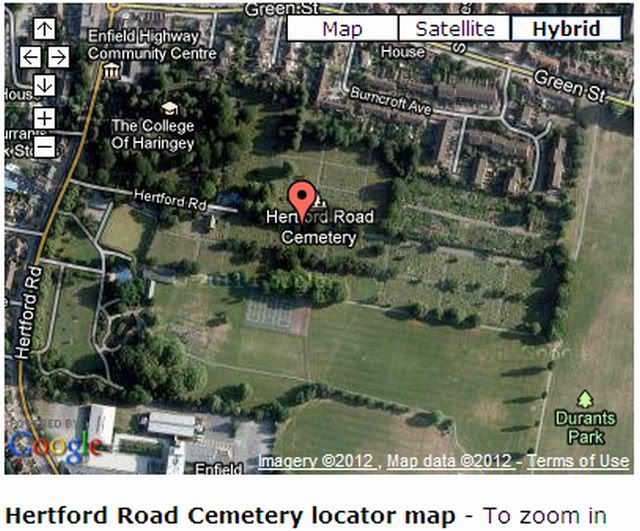 |
TinLizzy

|
Share to:




 #11
#11
|
-

-
Rank:Diamond Member

- Score:1225
- Posts:693
-
From:Canada

- Register:11/07/2008 01:17 AM
|
Re:Grave Photo Research WILLIAM WALLIS
Date Posted:05/07/2016 15:49 PMCopy HTML
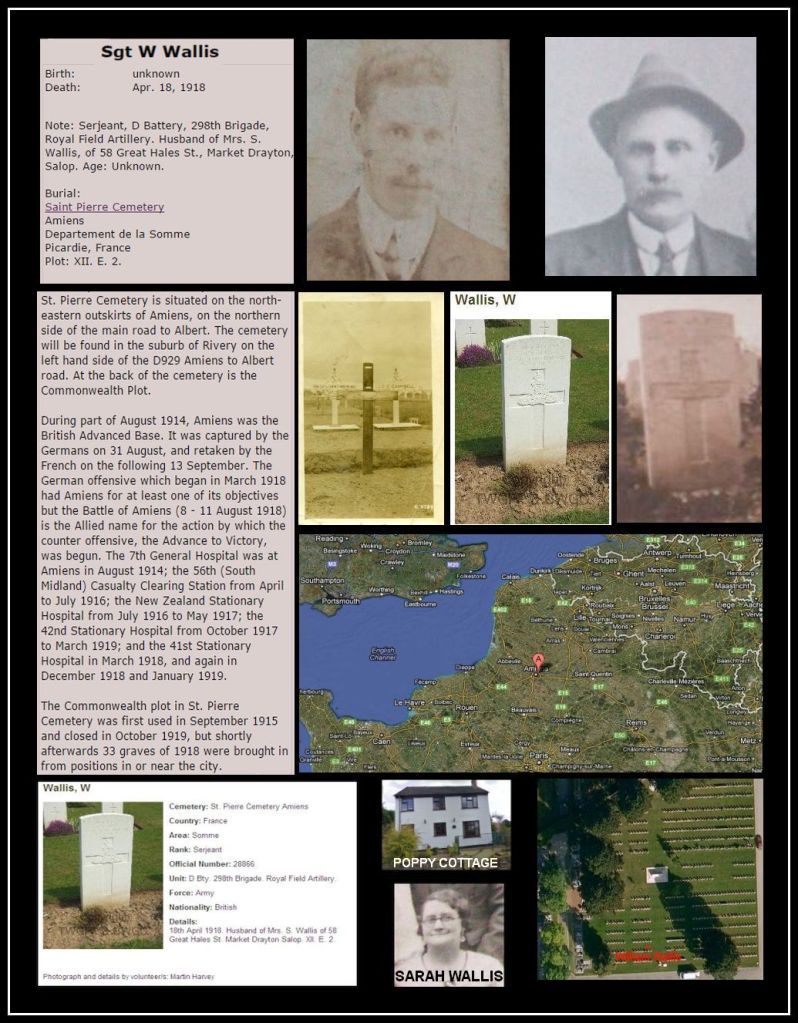 http://www.cwgc.org/find-a-cemetery/cemetery/20902/ST.%20PIERRE%20CEMETERY,%20AMIENS ST. PIERRE CEMETERY, AMIENSPrint pageST. PIERRE CEMETERY, AMIENS 
- Country:
- France
- Locality:
- Somme
- Identified Casualties:
- 747
Location InformationSt. Pierre Cemetery is situated on the north-eastern outskirts of Amiens, on the northern side of the main road to Albert. The cemetery will be found in the suburb of Rivery on the left hand side of the D929 Amiens to Albert road.
At the back of the cemetery is the Commonwealth Plot.
Visiting InformationFor your information, the opening time for St Pierre Communal Cemetery is 8:00 to 18:00. Historical InformationDuring part of August 1914, Amiens was the British Advanced Base. It was captured by the Germans on 31 August, and retaken by the French on the following 13 September. The German offensive which began in March 1918 had Amiens for at least one of its objectives but the Battle of Amiens (8 - 11 August 1918) is the Allied name for the action by which the counter offensive, the Advance to Victory, was begun.
The 7th General Hospital was at Amiens in August 1914; the 56th (South Midland) Casualty Clearing Station from April to July 1916; the New Zealand Stationary Hospital from July 1916 to May 1917; the 42nd Stationary Hospital from October 1917 to March 1919; and the 41st Stationary Hospital in March 1918, and again in December 1918 and January 1919.
The Commonwealth plot in St. Pierre Cemetery was first used in September 1915 and closed in October 1919, but shortly afterwards 33 graves of 1918 were brought in from positions in or near the city.
During the Second World War, Amiens was again a British base, and G.H.Q. reserve was accommodated in the area south-west of the town. There was heavy fighting in and around Amiens when the Germans broke through the Somme line and took the town on 18 May 1940. Much damage was done, but although all the houses to the west of the cathedral were completely destroyed by the bombardment, the cathedral itself and the church of St. Germain l'Ecossais survived. Amiens was retaken by the British Second Army on 31 August 1944. Nos. 25 and 121 General Hospitals were posted there in October 1944, remaining until April 1945.
St. Pierre Cemetery contains 676 Commonwealth burials of the First World War and 82 from the Second World War.
The Commonwealth plot was designed by Sir Edwin Lutyens.
http://www.findagrave.com/cgi-bin/fg.cgi?page=gr&GRid=56043655  |
TinLizzy

|
Share to:




 #12
#12
|
-

-
Rank:Diamond Member

- Score:1225
- Posts:693
-
From:Canada

- Register:11/07/2008 01:17 AM
|
Re:Grave Photo Research WILLIAM WALLIS
Date Posted:05/07/2016 16:09 PMCopy HTML
https://www.old-maps.co.uk/#/Map/367500/334500
|
Copyright © 2000- Aimoo Free Forum All rights reserved.







 #1
#1





 #2
#2





 #3
#3





 #4
#4





 #5
#5





 #6
#6





 #7
#7





 #8
#8





 #9
#9





 #10
#10






 #11
#11







 #12
#12









